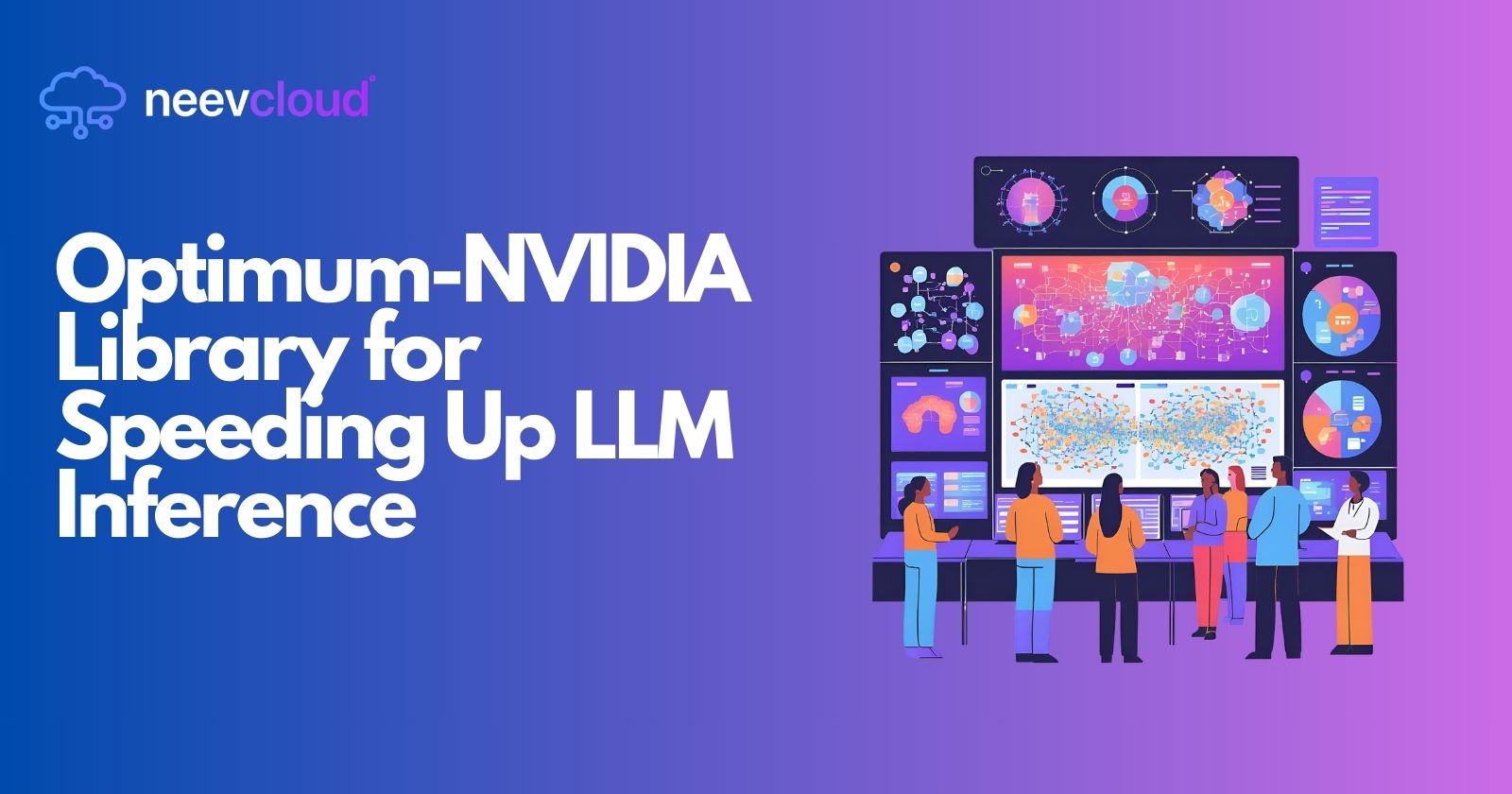Optimum-NVIDIA Library for Speeding Up LLM Inference
 Tanvi Ausare
Tanvi Ausare
In the AI-driven landscape, large language models (LLMs) power critical applications such as customer support chatbots, content generation tools, and complex recommendation systems. With the proliferation of these applications, achieving high-speed, efficient inference of LLMs has become essential, especially in environments like AI Cloud and AI Datacenters. NVIDIA, a leader in AI hardware and software, provides the Optimum-NVIDIA library, a toolkit designed to leverage their GPUs optimally, providing faster and more efficient LLM inference. This article dives into how the Optimum-NVIDIA library accelerates LLM inference and why it’s crucial for today’s AI infrastructures.
1. Introduction to Optimum-NVIDIA for LLM Inference
Optimum-NVIDIA is a specialized library created in collaboration between NVIDIA and Hugging Face.
It is built to facilitate deep learning model optimization on NVIDIA’s hardware, focusing on large language models (LLMs).
Aimed at both research and production settings, it provides critical tools for faster model inference, a crucial need for real-time AI applications.
The library supports a range of AI infrastructure environments, especially AI Cloud and AI Datacenters, optimizing LLM inference efficiency and performance.
2. Challenges in LLM Inference without Optimum-NVIDIA
Latency Issues: Without optimization, LLMs often suffer from higher latency, which is impractical for real-time AI applications.
Computational Costs: Running large models without optimization on GPUs results in increased compute costs, hindering the scalability of AI Datacenter solutions.
Resource Constraints: Standard LLMs consume significant GPU memory and processing power, reducing the availability of resources for other processes.
Lack of Customization: Developers face challenges in tweaking LLM inference to specific needs without a flexible and GPU-focused optimization library.
Energy Consumption: Inefficient LLM processing increases the carbon footprint, a critical concern for sustainable AI infrastructure.
3. Core Components of the Optimum-NVIDIA Library
Automatic Model Optimization: Leverages NVIDIA’s TensorRT to optimize model structures, ensuring faster inference while reducing memory usage.
Quantization: Supports quantization techniques to reduce model size, trading minimal accuracy for increased inference speed.
Multi-GPU Parallelization: Allows the distribution of inference tasks across multiple GPUs, ideal for large-scale AI Datacenter environments.
Memory Management: Provides features like memory pooling and efficient memory allocation to handle large models without memory overflow issues.
DeepSpeed Integration: Works seamlessly with Microsoft’s DeepSpeed to enhance LLM processing capabilities.
Integration with NVIDIA Tensor Cores: Utilizes the power of NVIDIA’s specialized Tensor Cores on GPUs for boosted performance on floating-point operations, common in LLM inference.
4. Advantages of Using Optimum-NVIDIA in AI Datacenters
Enhanced Throughput: AI Datacenters can handle a higher number of Large language model queries concurrently, boosting overall throughput.
Lower Latency for Real-Time Applications: With its optimization techniques, Optimum-NVIDIA ensures rapid response times, ideal for chatbots and other interactive LLM applications.
Reduced Compute Costs: The library’s efficient use of GPU resources minimizes cloud compute costs, making AI infrastructure more cost-effective.
Improved Scalability: Optimum-NVIDIA enables seamless scaling by reducing bottlenecks in GPU resource usage, critical for extensive AI Cloud environments.
Eco-Friendly Processing: By minimizing unnecessary computations, Optimum-NVIDIA helps reduce power consumption, aligning with sustainable AI goals in AI Datacenters.
5. Setting Up Optimum-NVIDIA for LLM Optimization
Installation: Optimum-NVIDIA is available through Python’s pip package manager, making installation straightforward for developers in AI Cloud environments.
Model Loading and Conversion: The library allows easy model loading with Hugging Face’s Transformers library, followed by conversion for optimized NVIDIA inference.
Configuration for TensorRT: Users can configure TensorRT settings within Optimum-NVIDIA to fine-tune model accuracy versus speed, based on AI Datacenter requirements.
Using Model Quantization: Optimum-NVIDIA provides tools for model quantization to further enhance inference speed by reducing bit precision.
Parallel Processing Setup: Configurations for multi-GPU inference allow distribution of workload, maximizing throughput in AI Datacenter environments.
6. Performance Benchmarks: Optimum-NVIDIA vs. Traditional Inference
Inference Speed: Benchmarks show Optimum-NVIDIA boosts LLM inference speed by up to 3x on average compared to traditional methods.
Memory Utilization: Optimum-NVIDIA’s memory optimization results in a 40-50% reduction in memory usage, crucial for AI Cloud environments with limited resources.
Scalability: Tests in multi-GPU setups highlight over 60% improved throughput with Optimum-NVIDIA, ideal for large-scale deployments.
Cost Efficiency: In cloud-based GPU setups, Optimum-NVIDIA reduces compute costs by approximately 30%, making it a highly economical choice for sustained AI workloads.
7. Use Cases of Optimum-NVIDIA in LLM Deployments
Real-Time Customer Service: Rapid response for chatbot LLMs in sectors like e-commerce, finance, and healthcare.
Content Generation Tools: High-performance LLM inference is essential for text generation applications in media and marketing.
Enterprise-level AI Solutions: Businesses relying on AI-driven insights benefit from lower inference latency and faster model response times.
Research and Development: Research institutions can optimize experimental LLMs, enabling faster model testing and evaluation.
8. AI Cloud Infrastructure: The Ideal Environment for Optimum-NVIDIA
Flexible Compute Resources: AI Cloud platforms allow easy scaling and allocation of GPU resources, essential for LLM optimization with Optimum-NVIDIA.
Efficient Resource Allocation: Optimum-NVIDIA enhances GPU utilization in cloud environments, allowing AI Clouds to serve more concurrent users.
Easy Deployment of Large Models: Deploying and scaling LLMs optimized with Optimum-NVIDIA in cloud settings eliminates the need for complex hardware management.
Seamless Integration with Kubernetes: AI Cloud platforms can leverage Kubernetes with Optimum-NVIDIA, streamlining deployment and scaling of LLM-based applications.
9. The Future of LLM Inference in AI Datacenters with Optimum-NVIDIA
Increased Adoption of AI-Powered Applications: Optimum-NVIDIA will facilitate the use of LLMs in new fields by reducing inference costs and increasing efficiency.
Broader AI Access: With reduced costs, even smaller enterprises can leverage AI Cloud resources for powerful LLM models.
Sustainable AI Development: Optimum-NVIDIA’s efficient GPU usage contributes to reducing the environmental impact of AI infrastructure.
Continued Optimizations: As NVIDIA and Hugging Face collaborate further, we can expect additional features aimed at lowering latency and increasing throughput, pushing AI boundaries in AI Datacenters.
10. Key Takeaways
Optimum-NVIDIA is an essential toolkit for accelerating LLM inference on NVIDIA hardware, ideal for AI Cloud and AI Datacenter use.
By optimizing GPU utilization, it allows faster response times, higher throughput, and more scalable LLM applications.
The toolkit’s benefits extend beyond speed, improving memory utilization, reducing compute costs, and promoting sustainable AI infrastructure.
It enables a wide range of AI applications, making it indispensable for real-time LLM applications such as chatbots, recommendation systems, and content generation.
With its straightforward setup, comprehensive GPU optimization features, and compatibility with cloud and on-premises environments, Optimum-NVIDIA is a critical tool for deploying scalable, efficient LLMs in AI-driven businesses.
Conclusion
The Optimum-NVIDIA library redefines LLM inference efficiency, especially in AI Cloud and AI Datacenter environments. By significantly reducing latency, optimizing memory use, and lowering compute costs, it enables businesses to deploy powerful LLMs at scale without compromising on performance or sustainability. With the growing demand for fast, efficient language models, integrating Optimum-NVIDIA into your AI infrastructure is a strategic move that not only maximizes your hardware investment but also enhances your AI capabilities, setting the stage for a more responsive and scalable AI future.
Subscribe to my newsletter
Read articles from Tanvi Ausare directly inside your inbox. Subscribe to the newsletter, and don't miss out.
Written by
